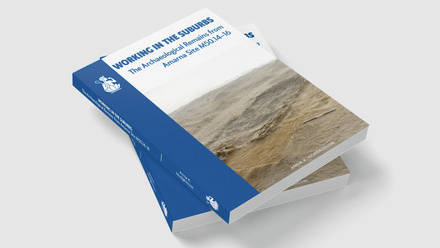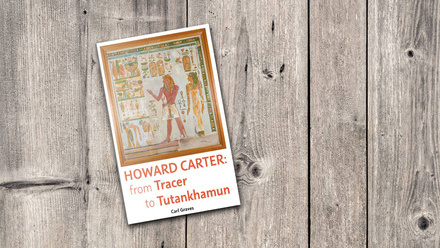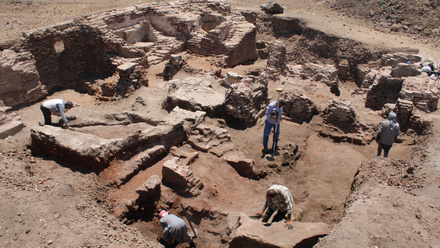The Naqada Regional Archaeological Survey and Site Management Project
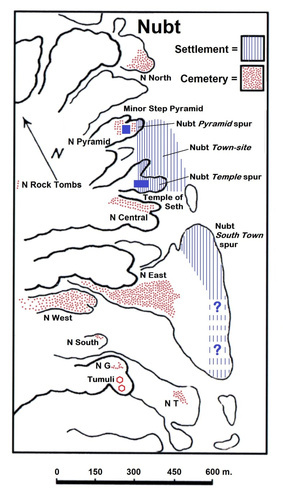
Left: Plan of Nubt
For the first time in 32 years work has resumed at the important site of Nubt (Naqada), discovered by Petrie 134 years ago. The EES/University of Winchester Regional Archaeological Survey started a pilot season in August 2018 to assess the condition and research potential of the site. A small team has examined various parts of this large site, with surface artefacts indicating dates ranging from the Middle Palaeolithic (ca. 100,000) through Naqada I (ca. 3,900 BC) to the Late Antique (AD 500). One of the aims of this project is to raise awareness of the importance of this site amongst the local people and the wider public, as well as protecting it for future generations. As such, future seasons will concentrate on various aspects of site management and conservation issues, before full-scale excavations start. The team are also surveying the wider region to place the site of Nubt within its regional setting and undertaking geoarchaeological work to understand the past environment.
History of Research in the Naqada Region
The site of Nubt was first excavated by Flinders Petrie in 1894, along with James Quibell, although the latter was primarily based at Ballas just north of Nubt and opposite the modern town of Zawaydeh. At the time Petrie was unaware that he was excavating one of the most important Predynastic sites in Upper Egypt, regarding the strange material he was excavating as belonging to invaders who had come into Egypt during the First Intermediate Period. Work by Jacques de Morgan in the Naqada Region however, indicated an earlier date and Petrie subsequently revised his findings and worked out a relative dating system that is still at the core of our chronology for early Egypt. His Sequence Dating method ordered the various stages of development during the Fourth Millennium BC and into the Third Millennium BC.
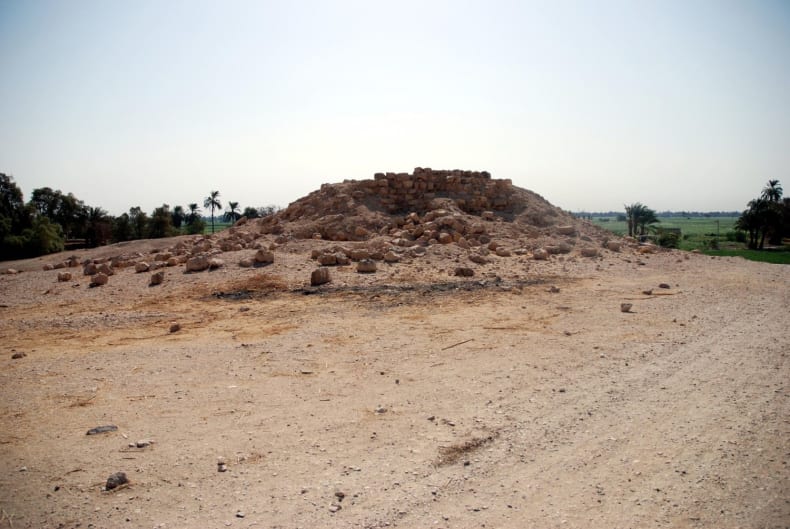
The minor step pyramid of Nubt
The Naqada region which equates to the Old Kingdom Coptite Nome has a number of important early sites where many famous researchers from the early days of Egyptology carried out excavations. Gaston Maspero at Khozam; Jacques De Morgan at both Nubt and Naqada; Ludwig Borchardt at Naqada; George Reisner at Ballas South, Deir el-Ballas and Naq el-Hai; John Garstang at Naqada. Later in the twentieth century, the region was visited by Werner Kaiser and Karl Butzer (at Nubt); Fred Wendorf (at Khattara) and Fekri A. Hassan (west bank survey).
After Petrie worked at Nubt and subsequently De Morgan’s work at same site, the site lay dormant for half a century until Kaiser returned to Nubt in 1958, with more extensive research staring in the 1970s. Thomas Hays surveyed the site between 1975 and 1977, Fekri Hassan carried out excavations between 1978 and 1981, and Claudio Barocas between 1977 and 1986.
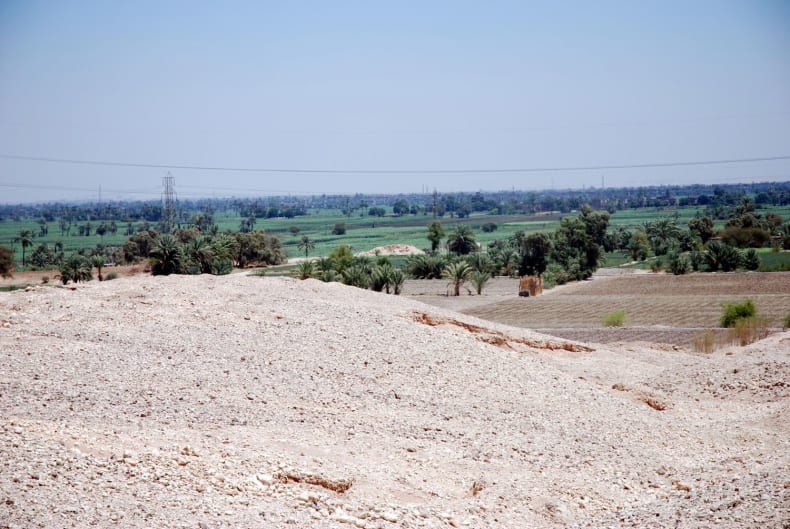
View of the minor step pyramid from the New Kingdom rock-cut tombs.
Whereas Nubt occupies an important place in the history of Egyptology, the site has in recent years been overshadowed by the extraordinary findings at Abydos and Hierakonpolis. The confusion resulting from the terminology has aggravated this. Petrie named the site ‘Naqada’ despite the fact modern Naqada is located several kilometres to the south and there being several archaeological sites in between as well as at modern Naqada. Here the ancient name of the dynastic part of the site is used: Nubt, ‘Gold Town’.
The History of Nubt
The city of Nubt is most famous for the Predynastic settlement of South Town and its associated cemeteries, such as the large communal cemetery N East and the elite cemetery N West, as well as the smaller special cemeteries of N T, N G, and N South. The dates for these graves range from Naqada IA (ca. 3,900 BC) to Naqada IIIC1 (ca. 3.060 BC). There are only a few Dynastic cemeteries that range from the Old Kingdom to the New Kingdom, as well as Ptolemaic to Roman. The city is spread over three spurs and the lower area in front of them. The earliest occupation was on Temple Spur, probably dating to Naqada I. Occupation on South Town Spur seems to begin from early Naqada II. This area seems to consist of a palace area, with indications for other areas of activities (including storage facilities and workshops).

Left: Was-sceptre of Amenhotep II, Copyright of the Victorian and Albert Museum, Museum no. 437-1895 (Copyright of the Victoria & Albert Museum).
The temple area at Nubt has a large amount of research potential, Petrie found evidence of a 4th Dynasty temple, which is overlain by a 12th Dynasty temple, and by an 18th Dynasty temple (in which the names of Thutmose I, Thutmose III, Amenhotep II and Amenhotep III are mentioned). It is probable that all of these kings enhanced and enlarged the Temple of Seth, Lord of Nubt, which appears to have later been appropriated by Ramesses II. The largest ever faience was-Sceptre, dating to the reign of Amenhotep II, was discovered in the Temple of Seth. One of the latest objects is a vase with the name of Sheshonq, indicating that the temple continued to function into at least the Third Intermediate Period, although there is no evidence for Ptolemaic or later use. Also on the Temple Spur is a large multi-period settlement, which in all probability dates back to the earliest graves in the cemeteries. On the surface Old Kingdom beer jars can still be found, along with New Kingdom pottery.
In the desert to the west of the temple four rock-cut tombs belonging to the priests from the Temple of Seth are located, dating to the 18th Dynasty. In front of these tombs is a lot of Roman and Late Antique pottery, along with a few Middle Palaeolithic stone tools.
Another important area is Pyramid Spur, that has the minor step pyramid of Nubt (sometimes identified as Ombos, Tukh, Naqada) located on it. This pyramid was probably built by king Huni at the end of the 3rd Dynasty as part of a series of such structures all around Egypt. This structure desperately needs a lot of conservation as well as protection.
The Local Workers
Petrie originally trained up the local workforce from Quft to work with him at Koptos, however, it was when working at Nubt that they really came of age, excavating a very large site (including 3,000 graves). This Qufti workforce remained with Petrie throughout his archaeological work in Egypt, travelling with him up and down Egypt. The descendents of this original workforce are now highly skilled and sought after, and work with various missions throughout Egypt. Today, the EES/University of Winchester Naqada Regional Archaeological Survey have as their reis, Omar Farouk, whose great-great-grandfather Hussein worked with Petrie at Nubt. For this pilot season, we have two other Qufti archaeologist with us, Yasseen Hassan Abduluhy Omar and Farouk Ali Farouk (photography).
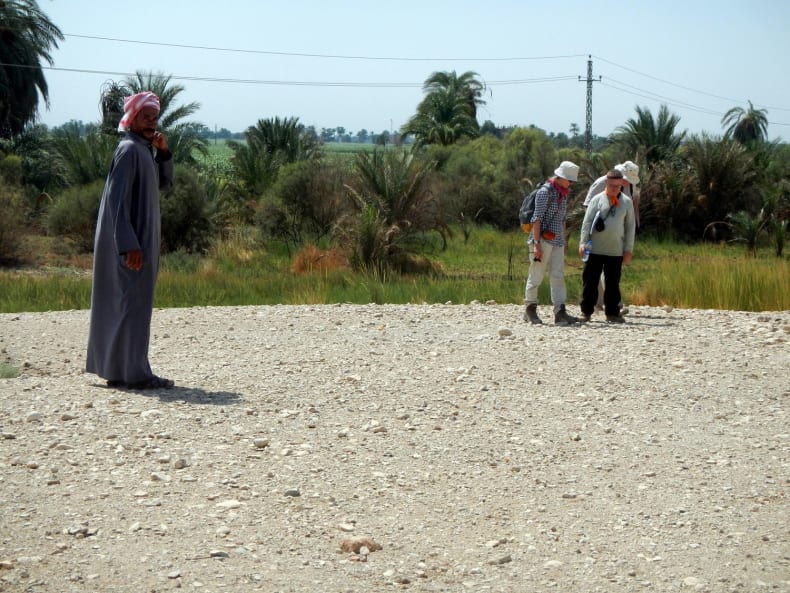
Surveying at Nubt
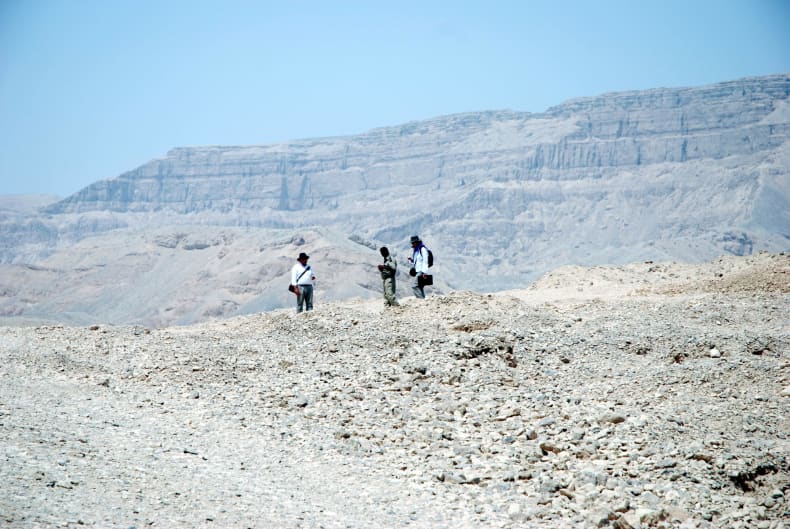
Surveying in the desert to the west of Nubt
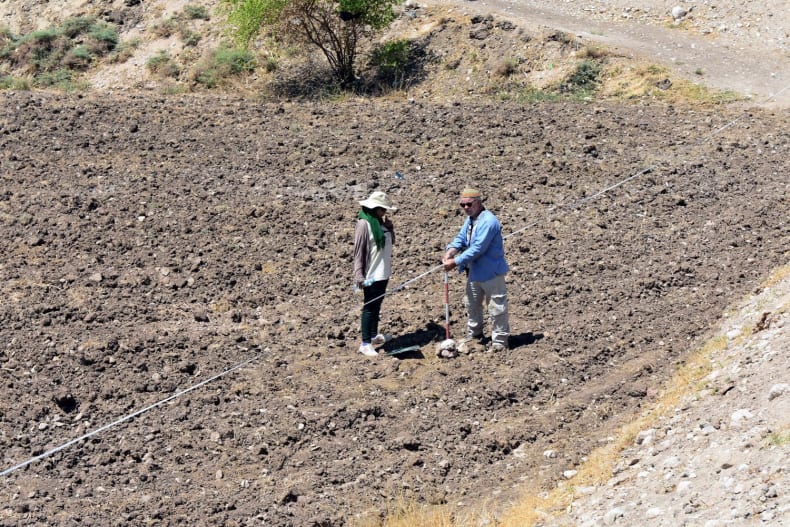
Laying out new grid squares at Manshiya, Kh.3.
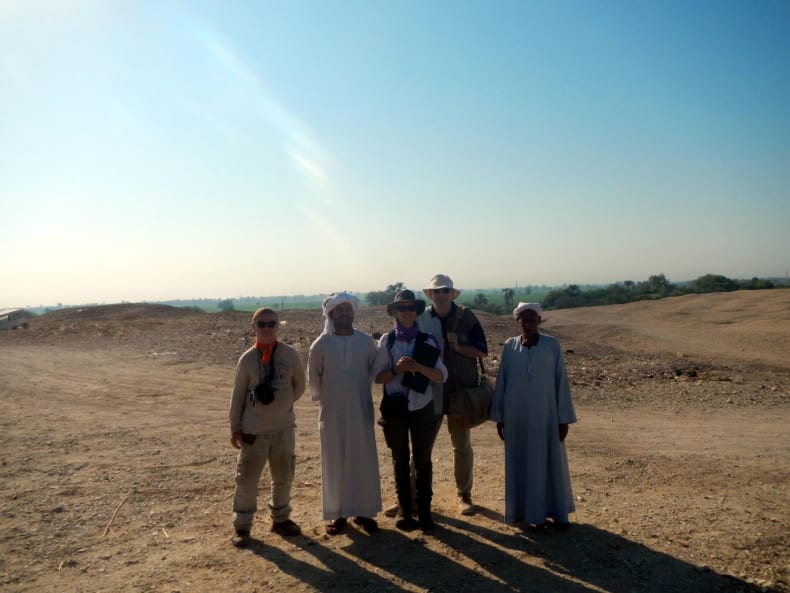
Omar, Joris, Tass, Jo and Yasseen at Nubt
Team Specialists
Geoffrey Tassie, University of Winchester, Director, Chipped Stone Artefacts, Small Finds
Joanne Rowland, University of Edinburgh, Assistant Director, Ceramics, Survey
Joris van Wetering, freelance: archaeologist specialising in the site of Nubt and the Naqada region
Richard Jaeschke, freelance: conservator
From Quft
Omar Farouk, Reis
Yasseen Hassan Abduluhy Omar
Our Supporters
2018 Pilot Project: Thames Valley Ancient Egypt Society.
Aspects of this project are also supported through J. Rowland’s project with the Newton Institutional Links – ‘Egypt’s Earliest Heritage’.
Seven Pillars of Wisdom Trust
Further Reading
Barocas, C., Fattovich, R. and Tosi, M. 1989. The Oriental Institute of Naples Expedition to Petrie’s South Town (Upper Egypt), 1977–1983: an interim report, in L. Krzyzaniak and M. Kobusiewicz (eds.) Late Prehistory of the Nile Basin and the Sahara. Poznan: Poznan Archaeological Museum, pp. 295–301.
Hassan, F. A., Tassie, G. J. van Wetering, J. and Banks, M. K. 2017. The exogenous/impressed decorated ceramics from the Naqada Region, in Y. Tristant, B. Midant-Reynes & E. M. Ryan (eds.) Egypt at its Origins 5: Proceedings of the Fifth International Conference “Origin of the State. Predynastic to Early Dynastic Egypt”, Cairo (Egypt), 13th-18th April 2014. Leuven – Paris – Walpole: Peeters, Orientalia Lovaniensia Analecta.
Hassan, F. A., van Wetering, J. and Tassie, G. J. 2017. Urban development at Nubt, in B. Midant-Reynes, Y. Tristant & E. M. Ryan (eds.) Egypt at its Origins 5: Proceedings of the Fifth International Conference “Origin of the State. Predynastic to Early Dynastic Egypt”, Cairo (Egypt), 13th-18th April 2014. Leuven – Paris – Bristol [CT]: Peeters, Orientalia Loveniensia Analecta 260, pp. 81-127.
Hassan, F. A., van Wetering, J. and Tassie, G. J. In Press. The Early Dynastic cemetery at el-Quleila North (Kh.2): Preliminary archaeological report, in E. C. Köhler, F. Junge, N. Kuch and A.-K. Jeske (eds.) Egypt at its Origins 6: Proceedings of the Sixth International Conference “Origin of the State. Predynastic to Early Dynastic Egypt”, Vienna (Austria), 10th-15th September 2017. Leuven – Paris – Bristol [CT]: Peeters, Orientalia Loveniensia Analecta.
Hays, T. R. 1984. Predynastic developments in Upper Egypt, in L. Krzy?aniak & M. Kobusiewicz (eds.) Origin and Early Development of Food-Producing Cultures in Northeastern Africa, Pozna?: Pozna? Archaeological Museum, pp. 211-19.
Holmes, D. L. In Press. Recollecting the Predynastic of Nagada Project, in A. De Trafford, G. J. Tassie, J. van Wetering & O. El Daly (eds.) A River Runs Through It: Studies in Honour of Prof. Fekri A. Hassan on the Occasion of his 75th Birthday. London: Golden House Publications, pp. 70-93.
Petrie, W.M.F. & Quibell, J.E. 1896. Naqada and Ballas. London.
di Pietro, G. A. 2017. Beyond the bounds of domestic life? Naqada: aspects of the settlement in the middle-late IV millennium BC, in B. Midant-Reynes, Y. Tristant & E. M. Ryan (eds.) Egypt at its Origins 5: Proceedings of the Fifth International Conference “Origin of the State. Predynastic to Early Dynastic Egypt”, Cairo (Egypt), 13th-18th April 2014. Leuven – Paris – Bristol [CT]: Peeters, Orientalia Loveniensia Analecta 260, pp.145-164.
Tassie, G. J. & van Wetering, J. 2011. ‘Re-excavating’ Predynastic sites in London, Ancient Egypt Magazine 11(4), Issue 64: 24-28.
Tassie, G. J. & van Wetering, J. 2013/4. The history and research of the Naqada region collection, in P. Piacentini, C. Orsenigo, and S. Quirke (eds) Forming Material Egypt: Proceedings of the International Conference in London, 20-21 May 2013, Special Edition of Egyptian & Egyptological Documents, Archives, Libraries (EDAL) 4: 61-77, Pl. VI-IX.
Tassie, G.J., van Wetering, J. & Carroll, I. 2010a. Repatriating prehistoric artefacts to Egypt: Prof. Hassan’s Naqada and Siwa study collections, Archaeology International 12: 52-57.
van Wetering, J., 2012. Relocating De Morgan’s Royal Tomb at Naqada and identifying its occupant in J. Kabaci?ski, M. Ch?odnicki & M. Kobusiewicz (eds.) Prehistory of Northeastern Africa New Ideas and Discoveries. Studies in African Archaeology 11, Pozna? Archaeological Museum, pp. 91-124.
van Wetering, J., 2017. The cemeteries of Nubt, Naqada Region, Upper Egypt in B. Midant-Reynes, Y. Tristant & E. M. Ryan (eds.) Egypt at its Origins 5: Proceedings of the Fifth International Conference “Origin of the State. Predynastic to Early Dynastic Egypt”, Cairo (Egypt), 13th-18th April 2014. Leuven – Paris – Bristol [CT]: Peeters, Orientalia Lovaniensia Analecta 260, pp. 521-549.
van Wetering, J. & G.J. Tassie, in press. Nubt (Petrie’s Naqada site, De Morgan’s Toukh site), an overview in A. Stevenson (ed.) The Many Histories of Naqada. London: GHP.

